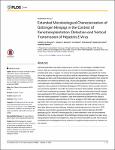Extended Microbiological Characterization of Göttingen Minipigs in the Context of Xenotransplantation: Detection and Vertical Transmission of Hepatitis E Virus
Morozov, Vladimir A.
Morozov, Alexey V.
Rotem, Avi
Barkai, Uriel
Bornstein, Stefan
Denner, Joachim
Xenotransplantation has been proposed as a solution to the shortage of suitable human donors. Pigs are currently favoured as donor animals for xenotransplantation of cells, including islet cells, or organs. To reduce the xenotransplantation-associated risk of infection of the recipient the pig donor should be carefully characterised. Göttingen minipigs from Ellegaard are often used for biomedical research and are regularly tested by their vendor for the presence of numerous bacteria, fungi, viruses and parasites. However, screening for some pathogens transmittable to humans had not been performed.The presence of microorganisms was examined in Göttingen Minipigs by PCR methods. Since zoonotic transmission of porcine hepatitis E virus HEV to humans has been demonstrated, extended search for HEV was considered as a priority. RNA from sera, islet and other cells from 40 minipigs were examined for HEV using different real-time reverse transcription (RT)-PCRs, among them two newly established. In addition, sera were examined by Western blot analysis using two recombinant capsid proteins of HEV as antigens. HEV RNA was not detected in pigs older than one year including gilts, but it was detected in the sera of three of ten animals younger than 1 year. Furthermore, HEV was also detected in the sera of three sows six days after delivery and their offspring, indicating vertical transmission of the virus. PCR amplicons were cloned, sequenced and the viruses were found to belong to the HEV genotype (gt) 3/4. Anti-HEV immunoglobulins G were detected in one sow and maternal antibodies in her six day old piglet. Since Göttingen minipigs were negative for many xenotransplantation-relevant microorganisms, they can now be classified as safe. HEV may be eliminated from the Ellegaard herd by selection of negative animals and/or by treatment of the animals.
Dateien zu dieser Publikation
Keine Lizenzangabe
Verwandte Publikationen
Anzeige der Publikationen mit ähnlichem Titel, Autor, Urheber und Thema.
-
2022-01-14ZeitschriftenartikelEpidemiologie der Virushepatitiden A bis E in Deutschland Dudareva, Sandra; Faber, Mirko; Zimmermann, Ruth; Bock, C.-Thomas; Offergeld, Ruth; Steffen, Gyde; Enkelmann, JuliaMit Virushepatitis A bis E werden verschiedene infektiöse Entzündungen des Leberparenchyms bezeichnet, die durch die Hepatitisviren A bis E (HAV, HBV, HCV, HDV und HEV) ausgelöst werden. Zwar ähneln sich die Krankheitsbilder, ...
-
2022-01-14ZeitschriftenartikelEpidemiologie der Virushepatitiden A bis E in Deutschland Dudareva, Sandra; Faber, Mirko; Zimmermann, Ruth; Bock, Claus-Thomas; Offergeld, Ruth; Steffen, Gyde; Enkelmann, JuliaMit Virushepatitis A bis E werden verschiedene infektiöse Entzündungen des Leberparenchyms bezeichnet, die durch die Hepatitisviren A bis E (HAV, HBV, HCV, HDV und HEV) ausgelöst werden. Zwar ähneln sich die Krankheitsbilder, ...
-
2015-07-06ZeitschriftenartikelOccult Hepatitis B Virus Infection in Nigerian Blood Donors and Hepatitis B Virus Transmission Risks Oluyinka, Opaleye O.; Tong, Hoang Van; Tien, Sy Bui; Fagbami, Ademola H.; Adekanle, Olusegun; Ojurongbe, Olusola; Bock, Thomas; Kremsner, Peter G.; Velavan, Thirumalaisamy P.Background: Occult hepatitis B virus infection (OBI) characterized by the absence of detectable HBsAg remains a potential threat in blood safety. We investigated the actual prevalence, viral factors and genotype of OBI ...

